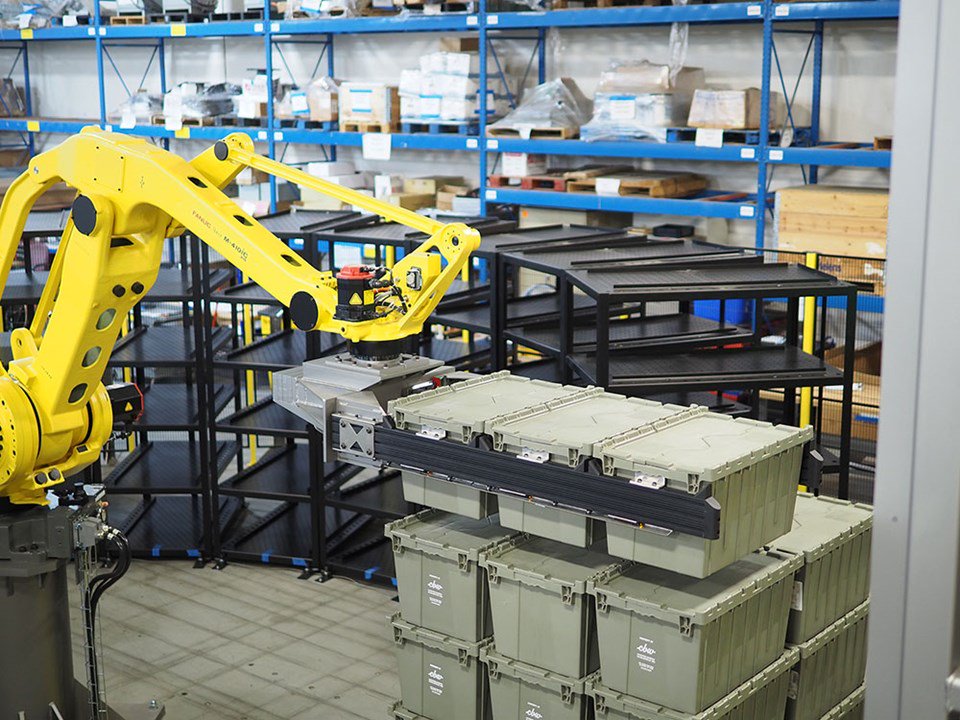
Maximize Floor Space, Optimize Ops with Robotic Buffering Systems
Michael Yochum | 22 March 2023
Order fulfillment operations play a crucial role in today's fast-paced world, where customers expect their orders to be processed and delivered quickly and accurately. With the increasing demand for seamless and efficient order fulfillment services, businesses are turning to innovative solutions to meet the needs of their customers. One such solution is the use of robotic buffer systems.
Leveraging Industrial Robots
Robotic buffering systems offer companies a dynamic solution that reduces operational expenses and optimizes upstream and downstream material handling processes. Robotic buffer systems allow for 24/7 automated operations, providing a reliable and consistent solution for order fulfillment. By automating the sequencing and storing of partial orders, workers can allocate their time to more meaningful tasks, while order accuracy and delivery times are improved.
Fully Automated Sequencing Solutions
Robotic buffering and sequencing systems operate by feeding and dispatching products to and from a robot cell via conveyor. The robot utilizes a custom end of arm tool to safely pick the product from the conveyor and place into the queue within the robot work envelope. As each product arrives, it is identified and processed in accordance with the requirements specified by the WES (warehouse execution system). Once all the product for an order has reached the buffer, the robot can either palletize the products or send them to the downstream conveyor for further processing.
Seamless integration with the WES makes it possible to monitor the movement of product in real-time, ensuring the proper routing of products based on order details, and accurate tracking of inventory. This communication enables the system to employ the end user’s business rules to sequence outbound product flow.
Typical requirements for order fulfillment operations include reverse stop sequencing and store planogram pallet build sequencing. Reverse stop sequencing contains multiple orders with the same route number, but orders can be associated with a different route stop. To optimize the delivery, customers want to load trucks in the reverse stop sequence according to the route plan.
In retail, the planogram (retail diagram that highlights where products are placed on shelves) drives the build sequence requirements because of specific placement on shelves in specific aisles. Building the load according to the planogram drives efficiency in their in-store replenishment operations.
Operational Impact
Flexible and Future-proof
A key benefit of robotic buffer systems is their design adaptability. They can be customized to fit new and existing facilities, optimizing upstream and downstream material handling equipment. This allows businesses to make the most of their existing resources and infrastructure, reducing the need for costly renovations and expansive infrastructure like conventional AS/RS (automated storage and retrieval systems) or fixed and inflexible solutions like large-scale industrial racking. Furthermore, the systems are modular and scalable, adapting to business growth as needed.
Another benefit of robotic buffer systems is their ability to handle a wide variety of product shapes and sizes. The robots can be equipped with multiple tooling options to handle cases, totes, trays, pails, bins, ties, and even heavy items, with precise and safe handling.
Process Optimization
Robotic buffer systems are designed for high system uptime, speed and reliability. Industrial robots are a very reliable and low maintenance alternative to traditional storage and retrieval systems.
Redundant buffer cells remove single points of failure and safeguard against cycle interruptions, ensuring that orders are processed and delivered without interruption. This provides peace of mind for businesses and customers alike, knowing that orders will be processed and delivered as expected.
In addition to increasing efficiency, robotic buffer systems reduce labor dependence and costs. The robots are designed to work continuously, reducing the need for manual labor and minimizing downtime. By reducing the need for manual labor, the risk of workplace injury is minimized, keeping workers safe and healthy.
The precise and safe automated handling of products ensures that they are not damaged during processing, reducing the risk of product loss or damage.
Reimagining Order Fulfillment with Robotic Buffering
The benefits and features of robotic buffer systems make them an ideal solution for order fulfillment operations. Whether you're looking to increase efficiency, reduce costs, improve worker safety, or offer faster and more accurate order fulfillment services to your customers, a robotic buffer system from Bastian Solutions can help you achieve your goals. Contact one of our solutions experts to discuss a tailored robotic buffering system today.
Michael is a Senior Application Engineer with the Robotics group of Bastian Solutions in St. Louis, MO since 2014. He has a Bachelor of Science degree in Industrial & Manufacturing Systems Engineering from the University of Missouri – Columbia. As an application engineer, Michael works with customers to design and integrate automated solutions for their material handling needs in manufacturing, distribution, and logistics.
Comments
No comments have been posted to this Blog Post
Leave a Reply
Your email address will not be published.
Comment
Thank you for your comment.